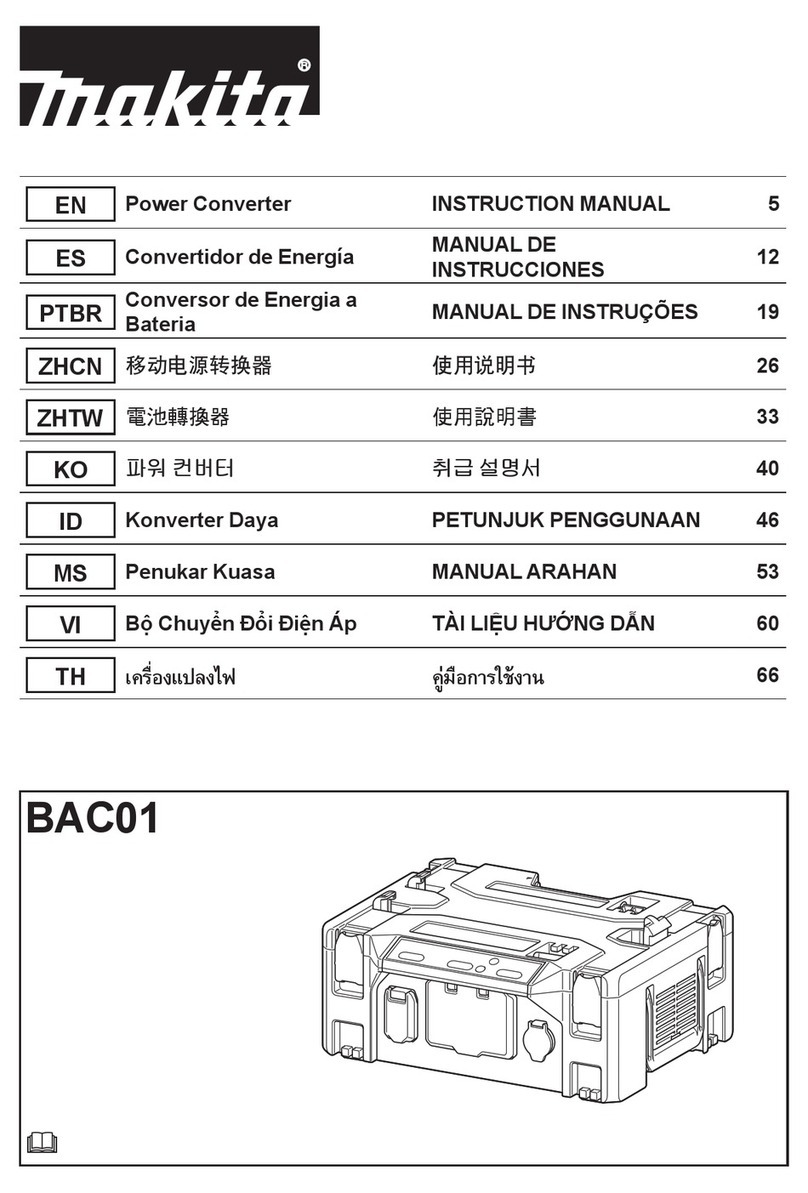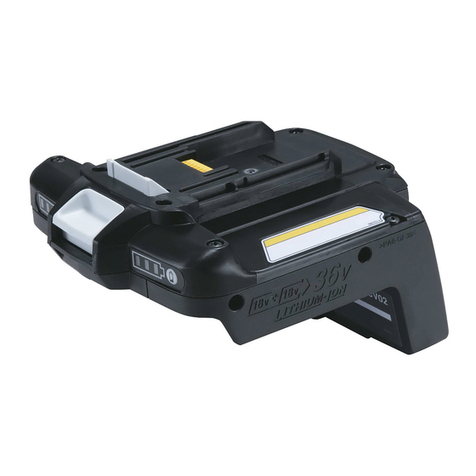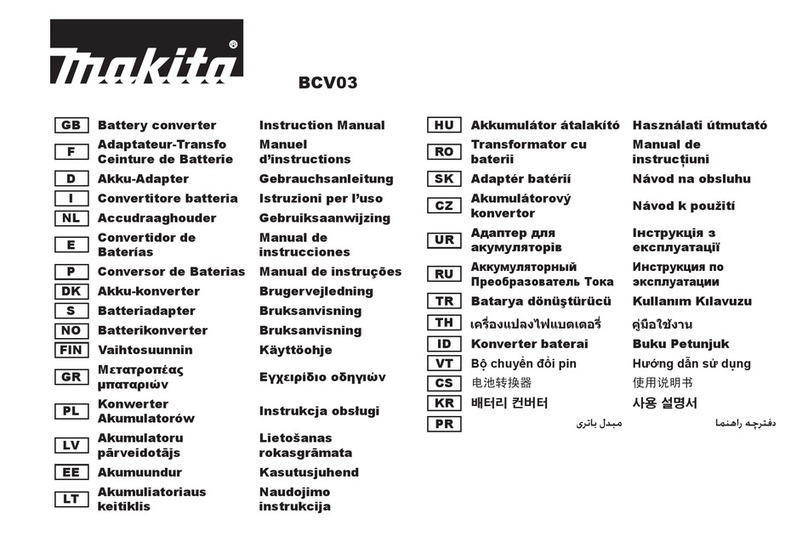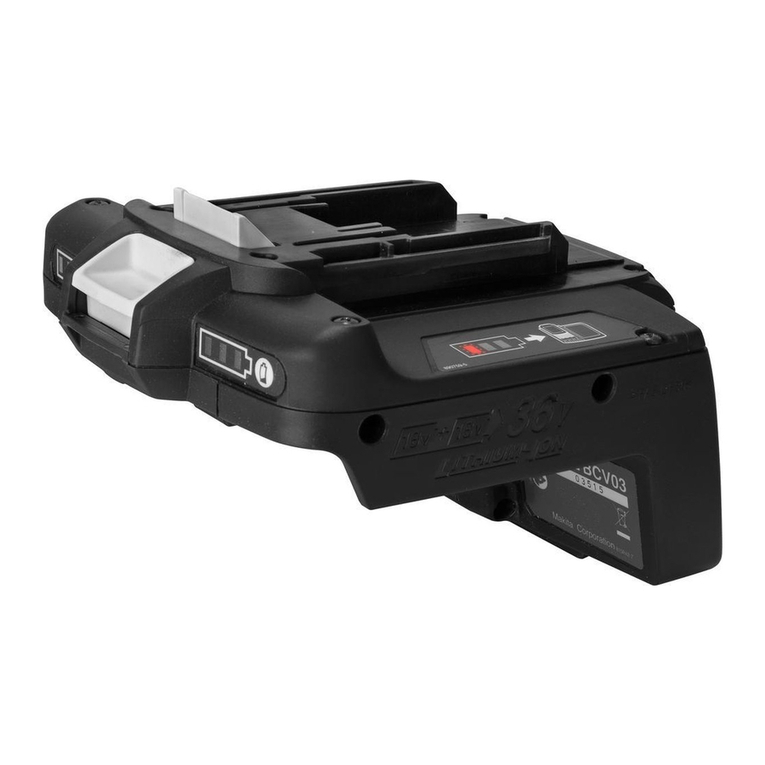
6
1 Couvercle
2 Batterie
3 Levier de verrouillage
4 Outil
5 Adaptateur pour raccordement
à l’outil
6 Cordon
7 Crochet
8 Ceinture
9 Vis
10 Bandoulière
11 Bouton d’affichage de la charge
restante de la batterie
12 Témoin de charge restante de
la Batterie 1
13 Témoin de charge restante de
la Batterie 2
14 Batterie 1
15 Batterie 2
Français (Instructions originales)
Descriptif
Applications
Ce convertisseur de batteries, en permettant l’utilisation séparée de l’outil et des batteries, facilite notamment
l’exécution du travail continu sur de longues périodes.
Ce convertisseur de batteries, prévu pour l’utilisation avec deux batteries de 18 V, peut être utilisé avec les outils
alimentés par des batteries d’une tension totale de 36 V.
Batterie compatible : BL1815N, BL1830, BL1840
Note : La BL1815 ne peut être utilisée avec le convertisseur de batteries.
ATTENTION
• Vous devez lire attentivement le manuel d’instructions de l’outil avant l’utilisation.
• Ce convertisseur de batteries est conçu exclusivement pour l’utilisation avec des batteries de 18 V. Ne l’utilisez pas
avec des batteries de 14,4 V.
• Installez deux batteries 18 V lors de l’utilisation. Ce convertisseur de batteries ne peut être utilisé avec une seule
batterie 18 V.
• Évitez de saisir ou de transporter le convertisseur de batteries uniquement par son cordon.
• N’insérez pas dans le chargeur l’adaptateur pour raccordement à l’outil. La charge n’est pas possible dans ce cas.
• Pendant l’utilisation, gardez le cordon à l’écart des obstacles tels que les branches. Il y a risque de blessure grave
si le cordon est retenu par des obstacles.
Insertion des batteries (Fig. 1 et 2)
ATTENTION
• Prenez garde de vous pincer les doigts sous le couvercle en insérant les batteries.
• Prenez garde d’échapper les batteries en les retirant.
• Soyez prudent lorsque vous retirez les batteries alors qu’elles sont orientées vers le bas, car elles risquent de sortir
de l’adaptateur et de tomber.
1. Faites glisser le levier de verrouillage de l’adaptateur utilisé pour loger les batteries 18 V, et ouvrez le couvercle.
2. Insérez les batteries à fond, jusqu’à ce que la partie rouge du bouton ne soit plus visible.
3. N’oubliez pas de verrouiller le couvercle avec le levier de verrouillage.
4. Fixez le crochet à votre ceinture ou à un dispositif similaire. (Fig. 3)
5. Fixez sur l’outil l’adaptateur pour raccordement à l’outil.
6. Vous pouvez aussi retirer le crochet et y faire passer la ceinture, tel qu’illustré.
Fixation de la bandoulière en option
La bandoulière en option peut être fixée tel qu’illustré. (Fig. 4)
Utilisation
Fixez le convertisseur de batteries sur vos vêtements, tel qu’illustré. (Fig. 5)
Indication de la charge restante des batteries (Fig. 6)
Appuyez sur le bouton d’affichage de la charge restante des batteries pour allumer les témoins et indiquer la charge
restante des batteries pendant environ 10 secondes. Les témoins correspondent à chacune des deux batteries.
NOTE
• Lorsque seul le témoin inférieur clignote pour la batterie 1 ou la batterie 2, cela signifie que la charge restante de
la batterie est faible, et l’outil ne fonctionne pas. Le cas échéant, chargez la batterie faible ou remplacez-la par une
batterie pleinement chargée. L’outil ne fonctionne pas lorsque l’une ou l’autre des deux batteries est épuisée.
• Pendant ou juste après l’utilisation de l’outil, la charge indiquée peut être légèrement inférieure au véritable niveau
de charge.

































